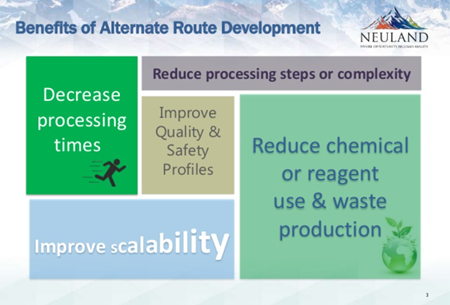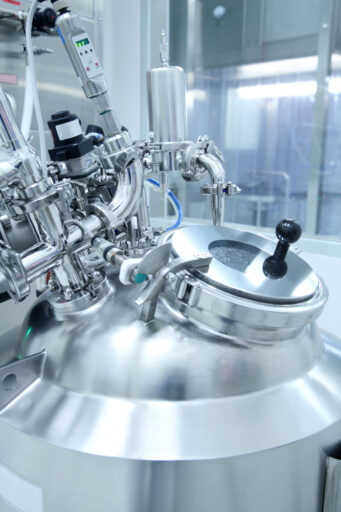 Demands on a drug’s synthetic processes naturally evolve during its lifecycle. Scouting alternative methods for synthesizing active pharmaceutical ingredients (APIs) early in process development — before they are needed by changing market conditions or other circumstances — offers you many benefits.
Demands on a drug’s synthetic processes naturally evolve during its lifecycle. Scouting alternative methods for synthesizing active pharmaceutical ingredients (APIs) early in process development — before they are needed by changing market conditions or other circumstances — offers you many benefits.
What are some of the key benefits of alternate route development?
Very simply, it reduces risks and costs, while providing improvements to your speed, efficiency, and safety. You may achieve:
- Decreased processing times —Made possible by simplified processes, alternative materials, reduced infrastructure, and other efficiency improvements.
- Reduced chemical or reagent usage and waste production — From developing green chemistry, atom economy, or other more sustainable approaches.
- Improved quality and safety profiles —For example, reducing the level of genotoxic or mutagenic impurities that your current method allows.
- Better scalability — Enabling efficiencies for faster production or larger yields.
- Fewer processing steps or reduced overall complexity — Reducing the amount or number of solvents or other chemicals required or simplifying the infrastructure necessary to perform the process.
- Diversifying supply chains or developing an alternative to a patented process — Alternatives can provide backup sources in case of supply chain security issues, sidestep patented processes, or reduce dependence on China and other high-risk sources of raw materials or synthesis chemicals.
What to Look for in New Synthetic Routes
When developing a new synthetic API route, you should look for a route that:
- is cost-effective.
- delivers the same or greater quality than the existing route.
- provides reasonable time to market.
Naturally, meeting all three of these criteria yields the most benefit, and can often fulfill 80–90% of typical business goals. But even focusing on just one or two of these criteria can provide significant process improvements. For niche products, most companies can expect to reduce cost by 2%–5% through alternate routes. The savings can be much greater in the case of generics, where reductions of 5% or more can potentially be achieved with alternative routes.
Alternate Route Scouting Basics
To achieve results like those listed above, the following are some of the most effective strategies for success:
- Your alternative route should use a strategically inexpensive starting material; using an intermediate from an existing process is ideal.
- The alternative process should be robust and require minimal purification. Stages should be telescoped for maximum efficiency.
- The new route should not infringe any current patents.
- You should understand starting material shelf lives and optimal retesting periods.
- Identify impurities and byproducts, avoiding routes with genotoxic impurities.
 In addition to cost, other factors to consider are batch sizes, throughput of the product, lead time and reducing batch cycle. Shortening the route is frequently a goal, as this one change can singlehandedly decrease cost, time, waste, infrastructure and regulatory constraints.
In addition to cost, other factors to consider are batch sizes, throughput of the product, lead time and reducing batch cycle. Shortening the route is frequently a goal, as this one change can singlehandedly decrease cost, time, waste, infrastructure and regulatory constraints.
Ask the Right Questions to Improve Alternate Routes
When considering a route change:
The first question to ask is why. By changing the route, what clear benefits can be gained in terms of cost, time and availability?
- What is the availability of your raw materials? Are they maximized by your current process, or could an alternate process improve upon it?
- Look at the volume of the product in the market. The higher the volume you need to produce, the more benefit you gain from improving the route at larger scales.
- Does the manufacturer you work with conduct company product profile matching? This can be very helpful when seeking to make a change. When examining the cost benefit, does it extend to the manufacturer as well as to you?
- Is the process feasible in the manufacturing plants you’ve selected?
- Determine if alternate green reagents can be used to maximize long-term product sustainability. Ideally, the new route should offer high “atom economy,” creating minimal waste via a greener process. Today, the most innovative routes use the least resources possible and minimize impact on the environment.
By guiding your research with these tips, you should be able to identify a synthetic route that meets your expectations and is sustainable across the drug lifecycle.










